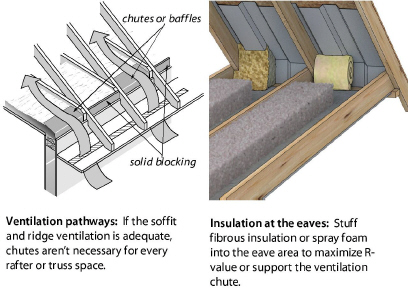
4.2 Insulating Attics and Roofs
Attic and roof insulation are two of the most cost-effective energy conservation measures.
An attic is a space under a roof where a person can walk or crawl. Buildings with flat ceilings are usually insulated above the ceiling and this is attic insulation.
Buildings with sloping ceilings or flat roofs are usually insulated in the roof cavity. Roof cavities aren’t usually accessible for walking or crawling.
A majority of buildings have fibrous insulation in their attics or roof cavities. Fibrous insulation is the most economical insulation for attics and roof cavities. Attics and roof cavities need ventilation for drying, cooling, and to reduce ice dams. See Fibrous Insulation Materials.

4.2.1 Preparing for Attic Insulation
|
SWS Detail: 4.1001.4 Vented Eave or Soffit Baffles, 4.1001.1 Non-Insulation Contact (IC) Recessed Lights |
These preparatory steps before insulating the attic.
✓ Repair roof leaks, remove other moisture sources, and repair other attic-related moisture problems before insulating attic.
✓ Remove hazardous materials, contaminated insulation, and debris from the attic, employing hazmat professionals as necessary.
✓ Vent all kitchen and bath fans outdoors through appropriate roof fittings, side wall fittings, or soffit fittings. See Fan and Duct Specifications.
✓ Seal the perimeter of the eave area, install baffles or chutes using mechanical fasteners such as staple or screws, and install insulation against the baffle maximize the R-value at the attic’s perimeter. Evaluate attic ventilation. See Attic Ventilation.
✓ Before insulating the attic, seal air leaks and bypasses as described in “Air-Sealing Attics and Roofs” on page 121
✓ Verify attic air-tightness as described in the MN WAP Policy Manual and Chapter 12.
✓ Install an attic access hatch if none is present, preferably at a large gable vent on the home’s exterior. An interior attic hatch should be at least 22 inches square if possible. Insulate the hatch to the same R-value as the surrounding attic. The roof’s height above the hatch may limit the thickness of insulation that you can attach to the back of the hatch door.
✓ Build an insulation dam around the attic access hatch two inches above the height of the insulation. Build the dam with rigid materials like plywood or oriented-strand board so that the dam supports the weight of a person entering or leaving the attic.

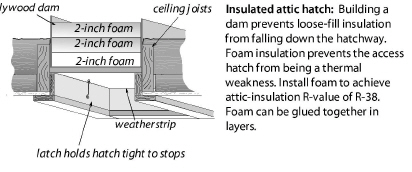
4.2.2 Safety Preparations for Attic Insulation
Before insulating the attic, protect the heat-producing fixtures, such as recessed light fixtures and chimneys, by installing shields. Without shields, the light fixture or chimney might ignite the insulation. Or, the insulation might cause a light fixture or chimney to become hot enough to ignite something else.
The shielding enclosure must often serve as the air-seal for the chimney or light fixture.
Types of Recessed Light Fixtures
There are three different types of recessed light fixtures and light-fan fixtures. (IC = insulation contact)
1. Non-IC-rated fixtures that must not touch insulation.
2. Type IC-rated fixtures that may be covered with fibrous insulation.
3. Type ICAT that are reasonably airtight (AT) and safe for contact with fibrous insulation.
Protecting Recessed Light Fixtures
Consider these options when preparing recessed light fixtures for attic insulation.
• Replace the recessed light fixture with a surface-mount fixture.
• Replace non-IC-rated fixtures with airtight IC-rated fixtures (ICAT). You can cover these ICAT fixtures with fibrous insulation after sealing the gap between the fixture and the surrounding materials.
• If the existing fixture is rated IC, you can seal the fixture to the ceiling with caulk and cover the fixture with fibrous insulation. Or you can enclose the fixture with a Class I fire-resistant enclosure, seal the enclosure to the ceiling with foam, and then cover the enclosure with insulation.
• In roof or attic cavities that are sheeted on both sides, either enclose non-IC recessed lights, as described previously, or replace them before dense-packing the cavities.
Caution: Spray foam insulation must not cover or surround recessed light fixtures or any other heat-producing devices.
Enclosing the Non-IC Fixture Remains
If an existing older recessed fixture, which isn’t labeled IC must remain in place, do these steps.

✓ Build a Class I fire-resistant enclosure over the non-IC-rated fixture leaving at least 3 inches clearance from insulation on all sides and to the lid of the enclosure. The top of this fire-resistant enclosure must have an R-value of 0.5 or less and extend 4 inches above the level of the new insulation.
✓ Notch the shields around wires.
✓ Seal the enclosure to the ceiling with foam or caulk.
✓ Don’t cover the top of the enclosure with insulation.
Protecting Chimneys
The requirements for protecting chimneys from contact with insulation vary widely from one building department to another. We know of three common approaches to insulating around chimneys, which are listed here beginning with the most restrictive.
1. Air-seal around the chimney using non-combustible material like 26 gauge galvanized steel. Seal the steel to the chimney with a high-temperature sealant.
2. After air sealing gaps, install non-combustible insulation shields around masonry chimneys and manufactured metal chimneys to keep insulation at least 3 inches away from these chimneys.
3. A clearance smaller than 3 inches may be allowed if the attic insulation is non-combustible or if the specifications of the vent material allow a clearance less than 3 inches. For example: type B gas vent has a typical minimum clearance of 1 inch and all-fuel chimneys have a typical minimum clearance of 2 inches.
4. If the insulation is non-combustible, such as blown fiberglass or rock wool, no clearance between insulation and manufactured or masonry chimneys is necessary if this option is permitted by local building officials.
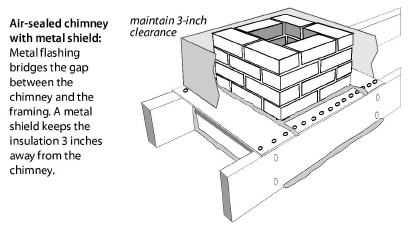
Electrical Junction Boxes
Observe these specifications during attic-insulation preparation.
1. Install covers on all electrical junction boxes that lack covers.
2. Use caulk or two-part foam to air seal electrical boxes that penetrate the ceiling (for light fixtures and fans), before blowing fibrous insulation over the boxes.
3. Flag the electrical boxes so that an electrician can find the boxes for future electrical work.
Knob-and-Tube wiring that comes in contact with insulation must be decommissioned. See “Decommissioning Knob-and-Tube Wiring” on page 50.
4.2.3 Blowing Attic Insulation
|
SWS Detail: 4.1005.2 Accessible Floors—Loose Fill Installation, 4.1005.4 Accessible Floors—Loose Fill Over Existing Insulation, 4.1005.8 Loose Fill Over Existing Insulation on Accessible Attic Floors |
Install attic insulation to a cost-effective R-value, depending upon existing insulation level and climatic region. Air seal attics before installing attic insulation. Air sealing may require removing existing insulation and debris that obstruct air sealing. See Removing Insulation for Attic Air Sealing.
Blown insulation is usually better than batt insulation because blown insulation forms a seamless blanket. Blown fibrous attic insulation settles: cellulose settles 10% to 20% and fiberglass settles 3% to 10%. Blowing attic insulation at the highest achievable density helps minimize both settling and air circulation within the blown insulation.
Observe these specifications when blowing loose-fill attic insulation.
✓ Calculate how many bags of insulation are needed to achieve the R-value specified on the work order from the table on the bag’s label.
✓ Install insulation depth rulers: one for every 300 square feet.
✓ Maintain a high density by moving as much insulation as possible through the hose with the available air pressure. The more the insulation is packed together in the blowing hose, the greater is the insulation’s installed density.
✓ Fill the edges of the attic first, near the eaves or gable end, then fill the center.
✓ When filling a tight eaves space, push the hose out to the edge of the ceiling. Allow the insulation to fill and pack against the chute or baffle.
✓ Install insulation to a consistent depth. Level the insulation with a stick if necessary.
✓ Post an insulation certificate, with insulation type and number of bags installed, installed thickness, coverage area, and insulation R-value at the attic entrance. See Insulation Receipt or Certificate.
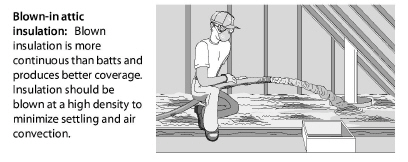
4.2.4 Closed-Cavity Attic Floors
|
SWS Detail: 4.1003.4 Cape Cod Side Attic Roof—Dense Pack Installation, 4.1005.6 Enclosed Attic Storage Platform Floor —Dense Pack Installation |
The ceiling joists in the attic are often covered by a wood floor for storage. You may have to remove some floor boards or drill the floor sheathing to install dense-packed insulation.
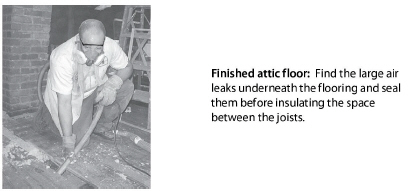
✓ Check for live knob-and-tube wiring in the cavity.
✓ Protect recessed light fixtures and other heat-producing devices in the floor cavity.
✓ Thoroughly seal the floor cavity’s air leaks before blowing insulation.
✓ Then dense-pack fiberglass or cellulose insulation into the spaces between the ceiling joists.
✓ Post an insulation certificate, with insulation type and number of bags installed, installed thickness, coverage area, and insulation R-value at the attic entrance. See Insulation Receipt or Certificate.
4.2.5 Insulating Closed Roof Cavities
Many existing homes have cathedral ceilings or flat roofs that are partially filled with fibrous insulation. These roofs are often unventilated or ineffectively ventilated. The insulation job may include repair of the roof deck and installation of foam insulation over the roof deck. The IRC building code requires one of these two approaches to insulate a roof cavity.
1. Verify or provide a ventilated space of at least one inch between the roof insulation and the roof sheathing by providing soffit and ridge ventilation.
2. If no roof ventilation, then install foam roof insulation in addition to filling the cavity with insulation. Foam R-value of between R-5 and R-35 depending on climate as specified by the IRC.
Ventilated Closed Roof Cavities
To prepare for roof-cavity insulation, without existing baffles and with a ventilated space above the insulation, use this procedure.
✓ Remove either the roofing and sheathing or the interior ceiling to gain full access to the cavity.
✓ Remove recessed light fixtures and replace them with surface-mounted light fixtures. Carefully patch and air seal the openings.
✓ Install fiberglass or foam insulation to meet the IECC regional minimum roof-assembly R-value requirements.
✓ Install openings into the ventilation channel above the insulation totaling 1/150 of the roof area. If the ceiling has a Class I or II vapor retarder, the requirement is reduced to 1/300 of the roof area.
✓ In cold climates, install a Class I or II vapor retarder at the ceiling. One option is to paint an oil-based primer over the interior drywall or plaster.
✓ Repair roof leaks or install a new water-tight roof. Replace moisture-damaged sheathing as part of the roof replacement.
✓ Install an air-barrier ceiling (drywall) if the existing ceiling isn’t an adequate air barrier. Or seal all seams that pull smoke from one inch at 25 PA with clear silicone caulk.
✓ Seal other air leaks with great care, especially at the perimeter and around ridge beams.
Un-Ventilated Closed Roof Cavities: Decisions
Many homes have cathedral ceilings, vaulted ceilings, or flat roofs that are partially or completely filled with insulation and would require major building surgery to install code-compliant roof ventilation or rooftop foam board during retrofit cavity insulation.
Dense-packing the cavities prevent most convection and moist-air infiltration, which are leading causes of moisture problems in roof cavities.
Insulators have dense-packed many cathedral roof cavities with fiberglass insulation without ventilation or foam rooftop insulation. Some experts believe that this is acceptable. However, this method isn’t a code-compliant one, and it usually requires special approval by the building department when and if the department issues a building permit.
Dense-packing a roof cavity without ventilation is controversial. The colder the climate, the higher the risk of ice damming or moisture damage to the structural sheathing, if the roof deck is not insulated with foam board at the same time.
Dense-packing the cavities prevents most convection and moist-air infiltration, which are leading causes of moisture problems in roof cavities.
Note: MN WX recommends that closed roof cavities that contain any areas more than 3.5 feet from a vapor permeable surface, not be dense-packed. Care should be taken to carefully air seal any penetrations to closed roof cavities before dense-packing.
To prepare for dense-packing the roof-cavity, consider the following steps.
✓ Reduce or eliminate sources of moisture in the home. See Solutions for Moisture Problems.
✓ Verify that the ceiling has a Class I or II vapor retarder and air barrier on the interior. If not, install a vapor retarder and air barrier.
✓ Remove recessed light fixtures and replace them with IC-AT fixtures or surface-mounted fixtures. Carefully patch and air seal the openings if you replace the recessed fixtures with surface-mounted ones.
✓ Seal other ceiling air leaks, large and small, with great care.
✓ When replacing the roof during roof-cavity insulation, install 1-to-8 inches of rigid high-density foam insulation on top of the roof deck. If you replace the roof, dense-pack the existing roof cavity as part of the process.
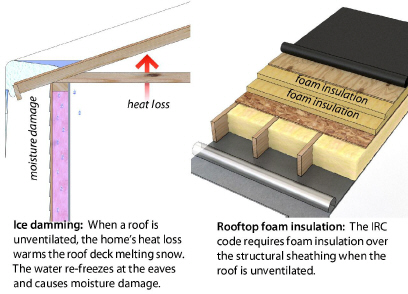
Important Note: Whether roof cavities can be safely dense-packed without ventilation is controversial and depends on climate. The colder the climate, the higher the risk of problems, such as ice damming. Dense-packing the cavities prevents most convection and moist-air infiltration, which are leading causes of moisture problems in roof cavities.
Blowing Insulation into the Closed Roof Cavity
Always use a fill tube when blowing closed roof cavities. Insert the tube into the cavity to within a foot of the end of the cavity. Access the cavity through the eaves, the roof ridge, the roof deck, or the ceiling. Consider one of these procedures.
• Drill and blow through a drywall ceiling.
• Carefully remove a tongue-and-groove ceiling plank and blow insulation into cavities through this slot.
4.2.6 Exterior Rooftop Foam Insulation
Only install rooftop foam insulation over dense-packed roof cavities. A ventilation space between existing insulation and the new rooftop insulation reduces the roof assembly’s R-value. Roofers install exterior foam roof insulation when re-roofing low-sloping roofs after filling the cavities with fibrous insulation.
✓ Use high density foam board: 2 pcf for polystyrene or 3 pcf for polyisocyanurate if the roof is flat or low sloping.
✓ Flash all external penetrations according to the roofing manufacturer’s specifications.
✓ Use a cool roofing material such as white rubber or white metal to limit the foam’s temperature during intense summer sun and to minimize cooling costs.
✓ Contact a design professional to make sure the roof will drain properly after foam installation.
✓ Provide an insulation certificate, with insulation type and number of bags installed, installed thickness, coverage area, and insulation R-value at the attic entrance. See Insulation Receipt or Certificate.
Many foam manufacturers can taper expanded polystyrene foam, providing wedge-shaped pieces to create slope for drainage. See Expanded Polystyrene (EPS) Foam Board. See Polyisocyanurate (PIC) Foam Board.
4.2.7 Installing Fiberglass Batts in Attics
|
SWS Detail: 4.1005.3 Accessible Floors—Batt Insulation Over Existing Insulation |
Follow these specifications when installing fiberglass batts in an attic. Fiberglass batts aren’t the best insulation for attics because of all their seams.
✓ When layering batts, install new layers at right angles to underlying layers if the top of the existing batts are level with or above the ceiling joist or truss bottom chord.
✓ Install un-faced fiberglass insulation whenever possible.
✓ If you must install faced batts, install them with the facing toward the heated space. Never install faced insulation over existing insulation.
✓ Cut batts carefully to ensure a tight fit against the ceiling joists and other framing.
4.2.8 Cathedralized Attics (Open Cavity)
A cathedralized attic has insulation attached to the bottom of the roof deck and is also called a hot roof. Choose to insulate the bottom of the roof deck instead of insulating the ceiling when the building owner wants to use the attic or to enclose an attic air handler and leaky ducts within the home’s thermal boundary.
Important: Insulating the underside of the roof deck presents a risk of moisture problems in the structural sheathing from roof leaks or condensation. To avoid moisture condensation within the insulation or within the structural sheathing during cold weather, install air-impermeable insulation such as closed-cell foam or install a perfect air barrier and a vapor retarder to the rafters beneath the insulation. (If the job requires a permit, see the IRC for guidance on its recommendations on rooftop insulation, required to prevent condensation and increase the assembly’s thermal resistance.)
Provide the client an insulation certificate, with insulation type and number of bags installed, installed thickness, coverage area, and insulation R-value. See Insulation Receipt or Certificate.
Spray Foam Roof-Deck Insulation
Use these procedures for spraying high-density, closed-cell foam on the underside of the roof deck.
✓ Remove any vapor retarder in the ceiling insulation at the floor of the attic.
✓ Create an airtight insulation dam at the eaves to form an air barrier at the roof-wall junction and to prevent spray foam from escaping into the soffit.
✓ Spray the foam to cover the entire surface of the cavity.
✓ Comply with fire safety provisions of the IRC as discussed in “Closed-Cell Spray Polyurethane Foam” on page 108.
Use only high-density closed-cell spray foam and not low-density open-cell spray foam for application to the bottom of a roof deck.

Fiberglass Roof-Deck Insulation
Insulating the rafter space with an air-permeable insulation requires an air barrier, vapor retarder, and Class I (or A) fire-rated material at the roof cavity’s lower boundary. Consider these two alternatives.
1. Install the rafter’s depth of fiberglass batts and then a material or combination of materials that constitutes an air barrier, vapor retarder, and Class I fire barrier.
2. Blow dense-packed fiberglass insulation between the roof deck using a rigid sheeting or flexible insulation restraint.
|
SWS Detail: 4.1003.1 Pitched/Vaulted/Cathedralized Ceilings—Loose Fill Over |
A vaulted attic is framed with a special truss that creates a sloping roof and a sloping ceiling. Access to the cavity varies from difficult to impossible.
Install insulation from either the top of the roof deck or through the ceiling. Insulation, installed at the ceiling, must have some stability to prevent gravity from pulling it downhill or wind from piling it, leaving some areas under-insulated.
Consider the following options to insulating uninsulated or partially insulated vaulted attics.
1. Insulate the ceiling with fiberglass batts. Install the batts parallel to the framing if the top of existing insulation is below the framing. Install the batts perpendicular to the framing if the top of the existing insulation is above the framing.
2. Insulate the bottom of the roof deck, as described previously for a cathedralized attic, if you remove the ceiling.
3. Insulate the ceiling with sprayed foam or batts from the roof with the roof sheathing removed.
4. Fill the cavity to approximately 100% with loosely blown fiberglass from indoors or through the roof. Maintain the existing vents and hope that settling or under-filling provides room for ventilation.
5. Preserve or install openings into the ventilation space above the insulation totaling 1/150 of the roof area. If the ceiling has a vapor retarder the requirement is 1/300 of the roof area.
Whatever option you choose, provide the client with an insulation receipt or certificate, with insulation type, number of bags installed, installed thickness, coverage area, and insulation R-value. See Insulation Receipt or Certificate.
4.2.10 Finished Knee-Wall Attics
|
SWS Detail: 4.1004.1 Preparation for Dense Packing, 4.1005.1 Accessible Floors—Batt Installation |
The finished attics of story-and-a-half or Cape-Cod homes require special care when installing insulation. They often include five separate sections that require different air-sealing and insulating methods. Seal air leaks in all these assemblies before insulating them. If necessary, remove the planking and insulation from the side-attic floor to expose the air leaks.
Use these specifications when insulating finished attics.
✓ Seal large air leaks between conditioned and non-conditioned spaces.
✓ Inspect the structure to confirm that it has the strength to support the weight of the insulation.
✓ Insulate access hatches to the approximate R-value of the assembly through which it is located.
✓ Post an insulation certificate, with insulation type, number of bags installed, installed thickness, coverage area, and insulation R-value at the attic entrance. See Insulation Receipt or Certificate.
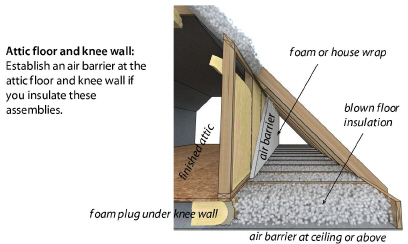
Attic Floor
There are a number of options for insulating the attic floor of a finished attic with knee walls. By attic floor, we mean the ceiling of the living space below with its ceiling joists and any floor sheeting installed over the joists for a storage platform.
• Install blown fibrous insulation over the ceiling, which should be an air barrier.
• Install blown fibrous insulation over existing insulation.
• Install fiberglass batts over the ceiling, which should be an air barrier.
• Install fiberglass batts over the existing insulation.
Whichever of these options that you choose, do the necessary air sealing to the attic floor before installing insulation. Also observe the preparations and safety precautions discussed in “Preparing for Attic Insulation” on page 137 and “Safety Preparations for Attic Insulation” on page 139.
Exterior Walls of Finished Attic
Insulate these walls as described in “Retrofit Closed-Cavity Wall Insulation” on page 186 or “Open-Cavity Wall Insulation” on page 190.
Collar-Beam Attic
Insulate this type of half-story attic as described in “Blowing Attic Insulation” on page 143.
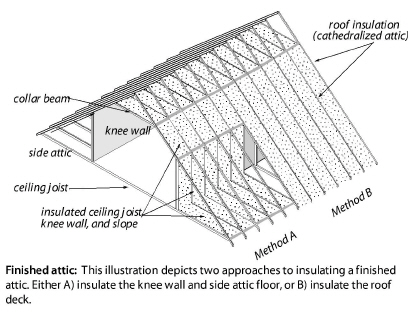
Sloped Roof
Insulate sloped roof with densepack fiberglass or cellulose insulation. Install plugs of fiberglass batt, or other vapor permeable material, at the ends of this cavity to contain the blown insulation while allowing it to breathe.
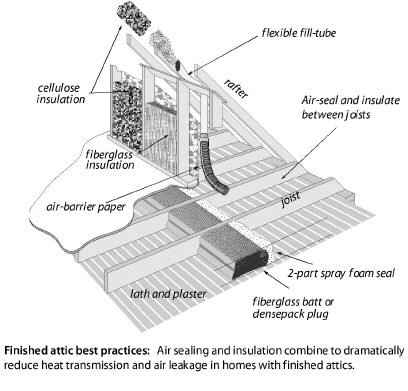
Insulate knee walls using any of these methods.
• Install un-faced fiberglass batts and cover the insulation with house wrap on the attic side. Prefer R-13 or R-15, 3.5-inch fiberglass batts.
• Install the house wrap or another insulation restrainer first and reinforce it with wood lath. Then blow dense-packed fibrous insulation into the cavity through the house wrap and patch the house wrap with tape. (Cellulose: 3.5 pcf; fiberglass 2.2 pcf)
• Spray the cavities with open-cell or closed-cell polyurethane foam after gaining access to the cavities and removing surface dirt to ensure good adhesion.
• For knee walls without framing, mechanically fasten rigid insulation to the wall’s surface and seal the seams.
Post an insulation certificate, with insulation type and number of bags installed, installed thickness, coverage area, and insulation R-value at the attic entrance. See Insulation Receipt or Certificate.
Preparation for Knee-Wall Insulation
Make whatever repairs and seal air leaks before installing the knee-wall insulation.
✓ Seal all large air leaks with structural materials.
✓ Seal all joints, penetrations, and other potential air leaks in the cavities with caulk or foam.
✓ Before installing caulk or spray foam insulation, clean dust and any other material that might interfere with the spray foam’s adhesion.
Air Sealing and Insulating under the Knee Wall
To seal and insulate under the knee wall, create an airtight and structurally strong seal in the joist spaces under the knee wall. Consider these options.
• Install sealed wood blocking between the floor joists covered with spray foam.
• Insert 2-inch-thick foam sheets and foam their perimeters with one-part or two-part foam.
• Insert a fiberglass batt into the cavity and foam its face with an inch of two-part closed-cell spray foam.
4.2.12 Access Doors in Vertical Walls
For kneewall access doors, observe the following.
✓ Insulate knee-wall access hatches and collar-beam access hatch with 3 or more inches of rigid-foam insulation.
✓ Weatherstrip the hatch and install a latch or other method to hold the access door closed against the weatherstrip.
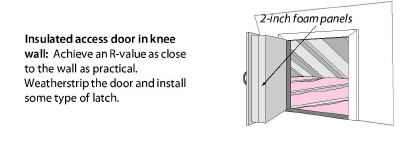

4.2.13 Walk-Up Stairways and Doors
Think carefully about how to install a continuous insulation blanket and air barrier around or over the top of an attic stairway. If you enter the attic by a stairwell and standard vertical door, use these instructions.
✓ Blow dense-pack fibrous insulation into walls of the stairwell.
✓ Install a threshold or door sweep, and weatherstrip the door.
✓ Insulate or replace the door with an insulated door if cost effective.
✓ Blow dense-packed insulation into the sloping cavity beneath the stair treads and risers.
You can also establish the thermal boundary at the ceiling level, but this requires a horizontal hatch at the top of the stairs.
When planning to insulate stairwells, investigate barriers such as fire blocking that might prevent insulation from filling cavities you want to fill. Also consider what passageways may lead to areas you don’t want to fill such as closets.
4.2.14 Insulating & Sealing Pull-Down Attic Stairways
Pull-down attic stairways are sometimes installed above the access hatch. Building a foam-insulated box or buying a manufactured stair-and-hatchway cover are good solutions to insulating and sealing this weak point in the ceiling insulation. Install weatherstripping around the insulated box.
Educate the client on the purpose and operation of stair-and-hatchway cover, and ask them to carefully replace it when they access the attic.
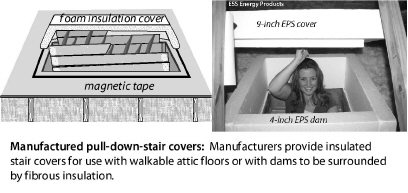
|
SWS Detail: 4.1088.4 Parapet Walls—Dense Pack, 4.1088.5 Parapet Walls—Spray Polyurethane Foam (SPF) |
Parapet walls are a continuation of exterior walls that rise above the roof. Parapet walls are often an air-leakage and thermal bridging problem because the insulation and air barrier aren’t continuous between the exterior wall and roof.
Inspect the parapet area from both indoors and outdoors and decide how to connect the wall insulation and air barrier with the roof insulation and air barrier. Consider these two alternatives.
1. Install an air barrier and dense-pack the wall cavity of the parapet.
2. Spray foam the parapet to connect the insulation and air barrier of the exterior wall with attic or roof insulation and air barrier.
Skylights are places where the insulation and air barrier may not be continuous. Inspect the insulation and air barrier of the skylight shaft. Install insulation and air seals as necessary to make a continuous insulated and air-sealed assembly as shown in the illustration.
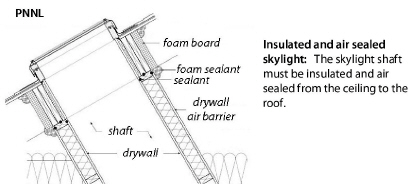
Whole-house fans can create significant thermal bridging if they aren’t dammed and insulated thoroughly around their perimeter. Whole-house fans can leak a lot of air if they lack an airtight seasonal cover.
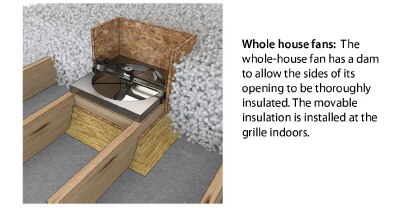
✓ Build a foam panel as thick as practical and install it inside the whole-house fan’s frame from indoors.
✓ Use clips or other restrainers to hold the panel in place.
✓ Install weatherstrip around the perimeter to limit air leakage.